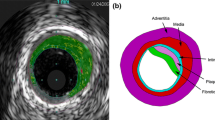Abstract
Finite-element modelling is used to simulate the response of atherosclerotic arteries to a balloon angioplasty procedure. Material properties for the normal wall are derived from experimental data, and the properties of the plaque are varied over a wide range. Comparison with experimental data shows that the normal aterial wall can be appropriately modelled using a hyperelastic material definition. Large-strain, nonlinear analysis was used to simulate the dilatation of three typical plaque configurations by an angioplasty balloon. Stress contour plots are presented for each configuration. Results show good agreement with previous histologic studies.
Similar content being viewed by others
References
Bergel, D. H. (1961): ‘The dynamic elastic properties of the arterial wall,”J. Physiol.,156, pp. 458–469
Carew, T. E., Vaishnav, R. N., andPatel, D. J. (1968): ‘Compressibility of the arterial wall,”Circ. Res.,23, pp. 61–68.
Carmines, D. V., McElhaney, J. H., andStack, R. (1991): ‘A piece-wise nonlinear elastic stress expression of human and pig coronary arteries tested,”J. Biomech.,24, (10), pp. 899–906
Castaneda-Zuniga, W. R., Sibley, R., andAmplatz, K. (1984): ‘The pathologic basis of angioplasty,”Angiology,35, pp. 195–205.
Chuong, C. J., andFung, Y. C. (1983): ‘Three dimensional stress distribution in arteries,”J. Biomech. Eng.,105, pp. 268–274.
Chuong, C. J., andFung, Y. C. (1984): ‘Compressibility and constitutive equation of aterial wall in radical compression experiments,”J. Biomech.,17, (1), pp. 35–40.
Cox, R. H. (1972): ‘A model for the dynamic mechanical properties of arteries’,-ibid. 5, pp. 135–152.
Dobrin, P. B., andDoyle, J. M. (1970): ‘Vascular smooth muscle and the anisotropy of dog carotid artery,”Circ. Res.,27, pp. 105–119
Dobrin, P. B., andRovick, A. A. (1969): ‘Influence of vascular smooth muscle on contractile mechanics and elasticity of arteries,”Am. J. Physiol.,217, pp. 1644–1651.
Dotter, C. T., andJudkins, M. P. (1964): ‘Transluminal treatment of atherosclerotic obstruction: Description of a new technique and a preliminary report of its application,”Circ.,30, pp. 654–670.
Doyle, J. M., andDobrin, P. B. (1973): ‘Stress gradients in the walls of large arteries,”J. Biomech.,16, pp. 631–639.
Hibbit, Karlsson andSorensen, Inc. (1989): ‘Abaqus theory manual’, V4.8
Hori, R. Y., andMockros, L. F. (1976)Indentation test of human articular cartilage.J. Biomech.,9, pp. 295–268.
Kinney, T. B., Chin, A. K., Rurik, G. W., Finn, J. C., Shoor, P. M., Hayden, W. G., andFogarty, T. J. (1984): ‘Transluminal angioplasty: A mechanical pathophysiological correlation of its physical mechanisms,”Radiol.,153, pp. 85–89.
Kleinberger, M. (1991): ‘An experimental and theoretical study of arterial viscoelasticity: applications to transluminal angioplasty’, Ph.D. dissertation, Duke University.
Lawton, R. W. (1957): ‘Some aspects of research in biological elasticity: Introductory remarks’, inRemington, R. W. (Ed): ‘Tissue elasticity’ (American Physiological Society, Washington DC).
Malvern, L. E. (1969): ‘Introduction to the mechanics of continuous medium’, (Prentice Hall, Englewood Cliffs, NJ).
Patel, D. J., andFry, D. L. (1964): ‘In situ pressure-radius-length measurements in ascending aorta of anesthetized dogs’,J. Appl. Physiol.,19, pp. 413–416.
Vito, R. P., andHickey, J. (1980): ‘The mechanical properties of soft tissues II: The elastic response of arterial segments,”J. Biomech.,13, pp. 951–957.
Wolf, G. L., LeVeen, R. F., andRing, E. J. (1984): ‘Potential mechanisms of angioplasty,”Cardiovascular Intervent. Radiol.,7, pp. 11–17.
Zarins, C. K., Lu, C. T., Gewertz, B. L., Lyon, R. T., Rush, D. S., andGlagov, S. (1982): ‘Arterial disruption and remodeling following balloon dilatation,”Surgery,92, pp. 1086–1095
Author information
Authors and Affiliations
Rights and permissions
About this article
Cite this article
Oh, S., Klelnberger, M. & McElhaney, J.H. Finite-element analysis of balloon angioplasty. Med. Biol. Eng. Comput. 32 (Suppl 1), S108–S114 (1994). https://doi.org/10.1007/BF02523336
Received:
Accepted:
Issue Date:
DOI: https://doi.org/10.1007/BF02523336




